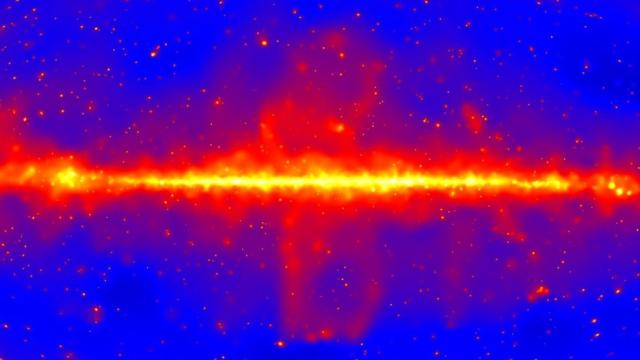Astronomers this week announced that they’d attempted to measure all of the starlight in the universe.
You might wonder why. Ultimately, they’re trying to tell the universe’s story.
“We wanted to know how star formation history proceeded,” Kari Helgason, scientist at the Max Planck Institute for Astrophysics in Germany, told Gizmodo.
The entire universe is diffuse with “extragalactic background light” or EBL, photons emitted by all of the galaxies’ stars in infrared, optical, and ultraviolet wavelengths. Going back in time, this light is the sum of all of the light emitted by stars from the Big Bang up until the moment and distance you look — remember, distance is the same as time in space, so looking at a farther region of space means looking at fewer stars.
The EBL can weaken gamma rays. So, scientists measured the gamma rays coming from distant quasars to see whether they carried the signature of a shadow from this starlight. With this information, the scientists can make a statement about the rate of star formation over time.
Researchers analysed gamma rays from nine years of data collected by the Fermi Gamma-ray Space Telescope. Specifically, they looked at 739 blazars, which are black holes spewing jets of matter pointed at the Earth, and one gamma-ray burst. These objects dated back 200 million to 11.6 billion years. They applied an equation to all of the data that calculated the total background light, according to the new study published in Science.
The results were consistent with past attempts to measure the extragalactic background light, showing that star formation hit its maximum around 10 billion years ago.
The extragalactic background light is exciting for other reasons, though, wrote Elisa Prandini, astroparticle physicist from the University of Padova in Italy, in a commentary for Science. The measurement provides a limit to how many faint galaxies there were around 12 billion years ago.
These galaxies are thought to have caused a “reionization era,” an important time in the history of the universe when, after the first atoms formed from protons combining with electrons, energy from the new galaxies split them back up. But very few sources were used to make that specific measurement, she wrote, so more observations of distant gamma-ray sources could clear things up.
On top of that, the extragalactic background light could provide a new way to hunt never-before-seen particles, said Prandini.
The study has its caveats, said Helgason — they assumed all of the background light came from starlight, but powerful black holes, too, can spew radiation into space. Current estimates suggest they aren’t a huge contributor, but they’re worth a deeper look just in case.
So, no, you don’t just go adding up all the universe’s starlight for nothing.
[Science]
